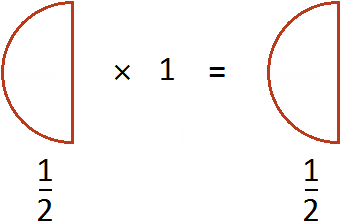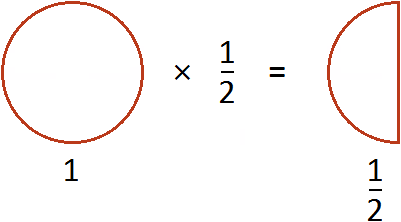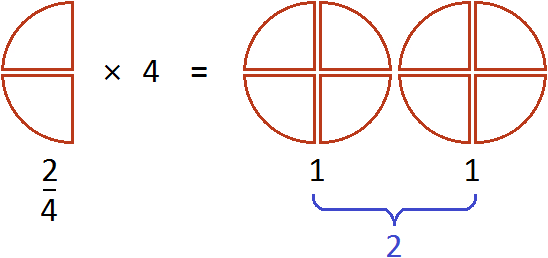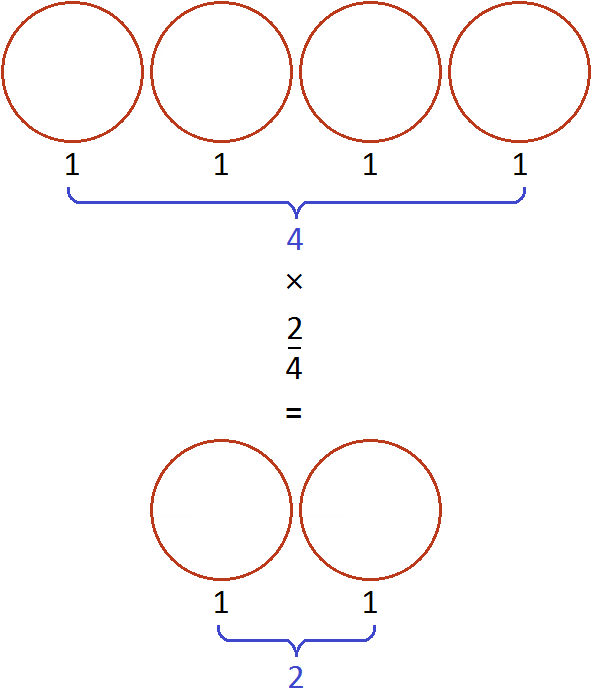To multiply a fraction by a number, multiply the numerator of the fraction by that number and leave the denominator unchanged.
Example 1. Multiply a fraction ![]() by the number 1.
by the number 1.
Multiply the numerator of the fraction ![]() by the number 1.
by the number 1.
![]()
The entry![]() can be understood as taking half 1 time. For example, if you take
can be understood as taking half 1 time. For example, if you take ![]() a pizza once, you get
a pizza once, you get ![]() pizzas
pizzas

We know from the laws of multiplication that if the multiplier and the factor are swapped, the product will not change. If ![]() is written as
is written as ![]() , then the product is still
, then the product is still ![]() . Again, the rule of multiplication of a whole number and a fraction is triggered:
. Again, the rule of multiplication of a whole number and a fraction is triggered:
![]()
This entry can be understood as taking half of one. For example, if there is 1 whole pizza and we take half of it, we have ![]() a pizza:
a pizza:

Example 2. Find the value of the expression ![]()
Multiply the numerator of the fraction ![]() by 4
by 4
![]()
The answer is an incorrect fraction. Let's separate the integer part of the fraction:
![]()
The expression ![]() can be understood as taking two quarters four times. For example, if you take
can be understood as taking two quarters four times. For example, if you take ![]() of a pizza 4 times, you get two whole pizzas
of a pizza 4 times, you get two whole pizzas

And if we swap the multiplier and the factor, we get the expression ![]() . It also equals 2. This expression can be understood as taking two pizzas from four whole pizzas:
. It also equals 2. This expression can be understood as taking two pizzas from four whole pizzas:

The number that is multiplied by a fraction and the denominator of the fraction are allowed to be reduced if they have a common divisor greater than one.
For example, the expression ![]() can be calculated in two ways.
can be calculated in two ways.
First method. Multiply 4 by the numerator of the fraction and leave the denominator unchanged:
![]()
The second way. The multiplied foursome and the foursome in the denominator of the fraction ![]() , can be reduction. These fours can be reduced by 4, because the greatest common divisor of two fours is the fourself:
, can be reduction. These fours can be reduced by 4, because the greatest common divisor of two fours is the fourself:

We get the same result 3. After reducing the fours, new numbers are formed in their place: two ones. But multiplying one with three and then dividing by one does not change anything. Therefore, the solution can be written in a shorter form:

Reduction can be performed even when we choose to use the first method, but at the stage of multiplying the number 4 and the numerator 3 we choose to use reduction:

But for example, the expression ![]() can only be calculated by the first method - multiplying the number 7 by the numerator of the fraction
can only be calculated by the first method - multiplying the number 7 by the numerator of the fraction ![]() , and leaving the denominator unchanged:
, and leaving the denominator unchanged:
![]()
This is due to the fact that the number 7 and the denominator of the fraction ![]() have no common divisor greater than one, and therefore do not reduce.
have no common divisor greater than one, and therefore do not reduce.
Some students mistakenly abbreviate the multiplied number and the numerator of a fraction. This should not be done. For example, the following entry is not correct:

The reduction of a fraction implies that both the numerator and the denominator will be divided by the same number. In the case of  , only the numerator is divided, because writing
, only the numerator is divided, because writing  is the same as writing
is the same as writing  . We see that division is performed only in the numerator, and there is no division in the denominator.
. We see that division is performed only in the numerator, and there is no division in the denominator.
2. If you find an error or inaccuracy, please describe it.
3. Positive feedback is welcome.